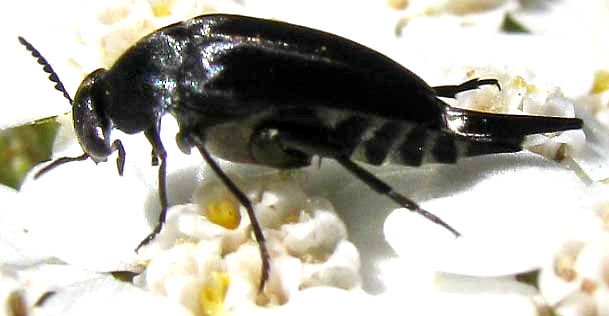Excerpts from Jim Conrad's
Naturalist Newsletter

from the July 5, 2009 Newsletter, issued from the Siskiyou Mountains west of Grants Pass, Oregon:
TUMBLING FLOWER BEETLE
Deep in the mountains far from any paved road I came onto a large, thriving population of Yarrow -- the same white-flowered, ferny-leafed Eurasian invasive "weed" found along roadsides and in fields these days all across North America. Maybe a log-pulling mule a hundred years ago left poop there with a Yarrow seed in it, and this pretty colony results.
Atop one Yarrow's flat-topped, lacy cluster of composite blossoms I spotted a black beetle with a remarkable shape. That's it above.
Have you ever seen a beetle with such a pointy rear end, or such a curved back? Bea in Ontario identified it as a Tumbling Flower Beetle, genus MORDELLA. The common Mordella species is M. marginata, and this could be that, but I read that just in the state of California there are dozens of Mordella species, so who knows?*
So, do tumbling beetles really tumble? What they do is to fall off their perches when disturbed, onto the leaves or ground below. It's more than a mere release of foothold, though. The hind legs are flattened and have an enlarged femur with which they can deliver a fair kick, which sometimes can result in a tumbling but more often just puts the beetle in a place other than where it was when it kicked. It's an escape mechanism not requiring too much thinking.
Bea Googled up the identity in just a few minutes and I asked how she did it. She replied, "I merely did a search in Google Images for: 'black beetle pointy abdomen' and I was lucky enough that it brought up one matching picture and I found out from that it was a Tumbling Flower Beetle, then I did a search for Tumbling Flower Beetle and so on... "
That's such a simple but powerful approach, using obvious keywords. Often when we use search engines we make it more difficult than it needs to be, groping for fancy concepts and terms, and end up not finding what we want.